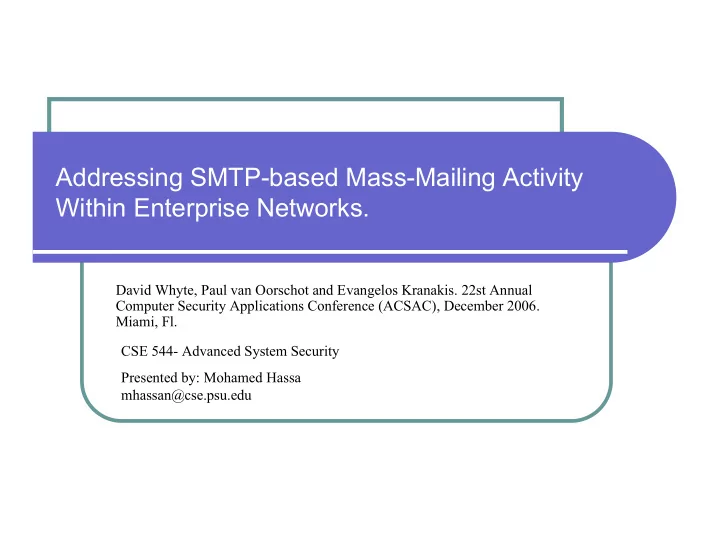

Addressing SMTP-based Mass-Mailing Activity Within Enterprise Networks. David Whyte, Paul van Oorschot and Evangelos Kranakis. 22st Annual Computer Security Applications Conference (ACSAC), December 2006. Miami, Fl. CSE 544- Advanced System Security Presented by: Mohamed Hassa mhassan@cse.psu.edu
An Attack Plan Target System Pennstate e-mail system (130,000 users ) Expected Results Disable communication between administration offices, organizations, professors and students. Take down or affect some services (psu email, listserv, angel) How we will do it: Generate a hit list for the psu domain (xyz123@psu.edu) “[a-z][a-z0-9] [a-z0-9][0-9]{0,5}@psu.edu” Size:3369.6x10 6 Time:3 days filter the list to 130,000 using psu directory search find a group of zombie machines (with smtp engine) where we can launch the attack from (not hard to find “botnet”) What will we send: spam, phishing, attachment with viruses few hundred messages for each user might take the server down (servers are overloaded) more fun! malformed spam will also take some clients down (outlook, Eudora,..) How can we prevent that?
The big problem Internet protocol suite Introduced in early 70’s and standardized in early 80’s Is the basis for the Internet Insecure by definition SYN attacks, IP Spoofing. Connection Hijacking, ICMP attacks, DNS attacks,… Application Level vulnerabilities (a lot in http, smtp pop,…) How can we fix it Replace it. Is that possible ?!! Unfortunately no Cost (Hardware, software,) Time, lack of coordination So if we cannot replace it we find work around to prevent attacks.
Problem definition Internet users receive daily tens even hundreds of emails which falls in the category of spam, phisihing, worms and viruses These mass mailing attacks originate from zombie machines without the owner’s knowledge Using the interaction between smtp engines and DNS, it is possible to detect malicious mass mailing activity within an enterprise network
DNS Records DNS is used to translate domain Example: cse.psu.edu name to ip address, reverse cse.psu.edu. 7146 IN A 130.203.4.2 lookup and lists mail servers for a psu.edu. 178 IN A 128.118.142.114 certain domain cse.psu.edu. 7116 IN NS psuvax1.cse.psu.edu. cse.psu.edu. 7116 IN NS neuromancer.cse.psu.edu. Categories of DNS records cse.psu.edu. 7116 IN NS taylor.ems.psu.edu. A : maps hostname to IPv4 cse.psu.edu. 7116 IN NS leibniz.math.psu.edu. address\ cse.psu.edu. 7200 IN MX 5 psuvax1.cse.psu.edu. AAAA: maps hostname to IPv6 cse.psu.edu. 7200 IN MX 80 neuromancer.cse.psu.edu. address cse.psu.edu. 7200 IN MX 90 meatwad.cse.psu.edu. CNAME: for hostname aliasing MX: maps a domain to a list of mail servers NS: maps a domain to a list of domain servers PTR: maps IPv4 address to hostnam
Contributions Build a software prototype that identifies mass mailing activities by observing DNS MX requests from a client. Reasons why the system is appealing (what they claim): Speed of detecting attacks Ability to detect zero-day worms Fast response by blocking port 25 of the melecious client Low false positives Ease of deployment
Related work Zoe et al. Modeled a mass mailing worm that makes use of users behavior Sidiroglou et al. build a system to detect zero day attacks by analyzing email content Gupta et al. use specification based anomaly detection that looks for change in mail traffic. Wong et al. characterize mass mailing activity wrt network traffic traces Musashi et al. a similar work that process DNS logs looking for MX queries associated with PTR queries
Methodology How it works? Normal Mail delivery Malicious Mail delivery
Methodology Hypothesis MX query behavior from ordinary clients are different then the behavior of malicious client Experiment to prove the hypothesis A university network of 300 users (heterogeneous environment) Monitored all internal and external DNS traffic and MX query activityfor a week Results of the Experiment Only 5 clients made MX query request. One was running SpamAssassin and the second is a mis-configured client and the other 3 are unknown !! (DHCP assigned) Conclusion most clients don’t need to perform MX queries (assuming that this network is representative) Any client performing an MX query (not an authoritative mail server nor white listed) is considered malicious ;
Solution and results The prototype The solution is a linux box placed over the network (probably at the gateway) It detects any client performing an MX query and contain that client by blocking port 25 using iptables. To deal with false positives a threshold can be configured to allow blocking after certain number of MX queries Also a whitelist is added to exempt some clients from the detection mechanism Results The system was able to prevent contain and prevent a worm aby detecting the first MX query and blocking the client
Limitations What Was mentioned Worms can use mail clients rather than smtp-engines. Therefore, they will go undetected because they use normal mail delivery The malicious client could have a predefined list of mail server to send to. Therefore, it will bypass the DNS server. DNS queries are done through remote DNS rather than local DNS (resolv.conf) Not mentioned The whitelited clients are the malicious clients Not all networks uses local DNS or local mail servers It doesn’t prevent relaying attacks
Conclusion What is good KISS No sophisticated mathematical models or state machines. Just use the basic behavier of the protocol Detecting attacks at the source rather than the destination seems to be a good approach. What is bad Approach The way they proved the hypothesis is lame The network they used is not representative They could have studied more of how different operating systems and applications that requires MX records They only tested that on one worm. Solution Limitations and assumptions makes their solution useless
Take Away Observing some trivial behavior of protocols could be a way to detect attacks. Too many limitations and assumption makes the solution less effective Overall, what do you think about the paper?
Questions? Thank You
Recommend
More recommend